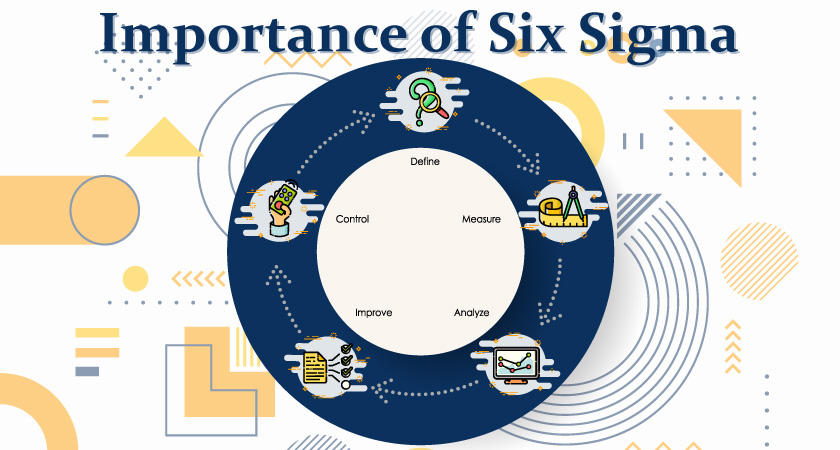What Is Six Sigma Concept, Steps, Examples

What Is Six Sigma? Concept, Steps, Examples
What Is Six Sigma?
Six Sigma is a methodology for process improvement developed by a scientist at Motorola in the 1980s. Six Sigma practitioners use statistics, financial analysis, and project management to achieve improved business functionality and better quality control by identifying and then correcting mistakes or defects in existing processes. The five phases of the Six Sigma method, known as DMAIC, are defining, measuring, analyzing, improving, and controlling.
KEY TAKEAWAYS
- Six Sigma is a quality-control methodology that businesses use to significantly reduce defects and improve processes.
- The model was developed by a scientist at Motorola in the 1980s.
- Companies often use the Six Sigma model to increase efficiency and boost profits.
- Six Sigma practitioners can earn certifications modeled on the color belts used in martial arts.
Understanding Six Sigma
Six Sigma is based on the idea that all business processes can be measured and optimized.
The term Six Sigma originated in manufacturing as a means of quality control. Six Sigma quality is achieved when long-term defect levels are below 3.4 defects per million opportunities (DPMO).
Six Sigma has since evolved into a more general business concept, focusing on meeting customer requirements, improving customer retention, and improving and sustaining business products and services. Among its best-known proponents was the longtime General Electric CEO Jack Welch.
Six Sigma certification programs confer belt rankings similar to those in the martial arts, ranging from white belt to black belt.
The Five Steps of Six Sigma
The Six Sigma method uses a step-by-step approach called DMAIC, an acronym that stands for define, measure, analyze, improve, and control. According to Six Sigma adherents, a business may solve any seemingly unsolvable problem by following these five steps:
Define
A team of people, led by a Six Sigma expert, chooses a process to focus on and defines the problem it wishes to solve.
Measure
The team measures the initial performance of the process, creating a benchmark, and pinpoints a list of inputs that may be hindering performance.
Analyze
Next the team analyzes the process by isolating each input, or potential reason for any failures, and testing it as the possible root of the problem.
Improve
The team works from there to implement changes that will improve system performance.
Control
The group adds controls to the process to ensure it does not regress and become ineffective once again.
What Is Lean Six Sigma?
Lean Six Sigma is a team-focused managerial approach that seeks to improve performance by eliminating waste and defects while boosting the standardization of work. It combines Six Sigma methods and tools and the lean manufacturing/lean enterprise philosophy, striving to reduce the waste of physical resources, time, effort, and talent while assuring quality in production and organizational processes. Any use of resources that does not create value for the end customer is considered a waste and should be eliminated.1
Six Sigma Certification and Belt Rankings
Individuals can obtain Six Sigma certification to attest to their understanding of the process and their skills in implementing it. These certifications are awarded through a belt system similar to karate training. The belt levels are:2
- White belt. Individuals with a white belt have received some instruction in the basics of Six Sigma, but have not yet gone through any formal training or certification program. This gives them enough knowledge to become team members.
- Yellow belt. This level can be attained after several training sessions, and equips participants with the knowledge to lead small projects and assist managers who hold more advanced belts.
- Green belt. To achieve this level, individuals take a more comprehensive course that prepares them to become project leaders.
- Black belt. After reaching the green belt level, participants can move on to black belt certification, preparing them for leadership roles in larger and more complex projects.
People with black belts can become masters and champions. Someone with a master black belt is considered an expert and strong leader with excellent problem-solving skills. A champion is a lean Six Sigma leader trained in maximizing profits through the elimination of waste and defects.
Real-World Examples of Six Sigma
Six Sigma is used by many companies, local governments, and other institutions. Here are two examples of how Six Sigma improved operational efficiency, saved money, and increased customer satisfaction.
Microsoft
Microsoft (MSFT) is one of the largest software producers in the world. It used Six Sigma to help eradicate defects in its systems and data centers and systematically reduce IT infrastructure failures.
The company first established standards for all of its hardware and software to create a baseline measurement for detecting defects. It then used root-cause analysis, including collecting data from past high-priority incidents, server failures, and recommendations from product group members and customers, to pinpoint potential problem areas.3
Large amounts of data were collected on a daily and weekly basis from various servers. The incidents were prioritized based on how severely the defects affected the business and the company's underlying services. Data analysis and reporting identified the specific defects, after which remediation steps for each defect were established.
As a result of Six Sigma, Microsoft says it improved the availability of its servers, boosted productivity, and increased customer satisfaction.
Ventura County, California, Government
Ventura County, California, credited the use of Lean Six Sigma for a savings of $33 million. The county government began to use the program in 2008 and has trained more than 5,000 employees in the methodology. The county says the savings are due in part to the introduction of more efficient new systems and by eliminating unnecessary, but time-consuming, steps from its prior processes.4
For example, the VC Star newspaper reported in 2019 that the county saved "$51,000 with an appointments system that reduced labor costs and rates for maintenance of county vehicles [and] almost $400,000 annually by implementing a new system to track employee leaves of absence."
Powered by Froala Editor